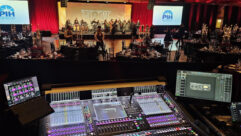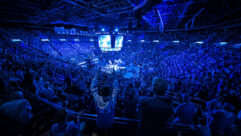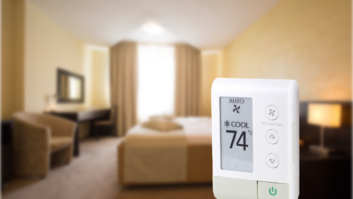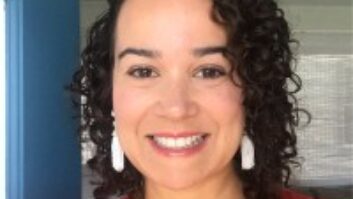A Cluster of SoundThe Oakdale Theatre went from tent to full-scale theater, and its sound system followed suit.
Feb 20, 1997 12:00 PM,
By Sam McDonaldMcDonald writes for the sound contracting industry.
The new Oakdale Theatre in Wallingford, CT, serves as an excellent example of the multiple challenges of modern sound-reinforcement system design. The theater, owned by the privately held Oakdale Development Partners, hosts live entertainment ranging from the Broadway touring production of “Hello Dolly” to Bruce Springsteen in concert. With a capacity for 5,500, the room includes an orchestra section, main floor seating and a luxury suite section topped by a large balcony.
It’s quite a difference from the original facility, which began as a tent facilitating in-the-round productions. Later, a roof was built, creating a “summer shed” with a capacity for about 2,000. Late in the summer of 1995, plans began for a new theater on the site: the Oakdale Theatre. Portions of the original structure were converted to the front lobby and lounge of the new building, and a completely new performance facility was constructed.
T he Oakdale partners selected North American Theatrix, Watertown, CT, to provide the sound-system design and installation. The audio design team, headed by Jeff Mele of North American Theatrix, consisted of Mele’s partner Gary Scott Peck, Brad Snow of Snow Sound, Berlin, CT, and the theatre’s chief audio engineer, Joe Miko. Mark Holden of Jaffe, Holden, Scarborough Acoustics of Norwalk, CT, provided the acoustic design.
“Jaffe, Holden, Scarborough did a tremendous job with respect to the acoustics. The room is relatively dead,” said Peck. The ceiling, more than 110 feet (33 m) from the main floor, is covered by drop ceiling sections of varying levels that trap sound. Flat wall spaces are covered by acoustic panels, the floors are covered by carpet, and seats are upholstered.
The room has an open feel, with seating divided into sections and forming a fan around the front stage. This stage is 60 feet (18 m) wide at the proscenium base, but immediately behind this, itswidth doubles. The stage is 65 feet(20 m) deep.
Need for versatility”When we received the blueprints for the room, we carefully scaled the room and determined distances the loudspeakers would be required to cover and how areas would be covered,” said Mele. “One primary consideration was a need for the sound system to be versatile, to provide appropriate reinforcement for acts from Broadway to Pearl Jam.”
Primary reinforcement would be provided by two loudspeaker clusters, flown left and right of the proscenium. The concern then became finding loudspeakers that would provide enough throw, with requisite clarity and smooth frequency response, to reach the rear of the balcony seating area well more than 150 feet (46 m) from the clusters. One other primary factor was a request from the owners not to stack any subwoofer loudspeakers on the ground or under the stage. This dictated that the low-frequency devices be flown with the clusters and that they must provide the necessary output while fitting within the array structure.
Eastern Acoustic Works (EAW) KF series loudspeakers were selected for the main arrays. Peck notes that this selection was based upon a number of factors. North American Theatrix enjoys a long-standing relationship with EAW, and it has successfully implemented a wide range of the company’s loudspeakers on previous projects. Peck adds that the EAW KF series is the most common request on concert touring “riders,” so acceptance by visiting acts is likely in most cases.
“One of the problems with other loudspeakers is that there is no way to control them or optimize their sound quality without their own dedicated processors,” Mele said. “We’ve found that EAW loudspeakers work well with a variety of processors, and in this case, because we had the luxury of BSS processors, we were able to really fine tune the loudspeakers. We also find that the horn-loaded midrange takes the voice and puts it out in frontof everything.”
Multiple arraysThe left and right main clusters are divided into three levels, with each level having an array of four loudspeakers. The top level comprises three EAW KF853 high Q mid-high loudspeakers, providing a 30—40 coverage pattern, along with a single BH853 low-mid loudspeaker, flown almost straight out and covering almost the entire balcony. The BH853, with two 15 inch woofers in a vented enclosure arraying with the other loudspeakers, bolsters the lower and middle frequencies.
“The BH853s provide just the right amount of extra low-mid in combination with the KF853s,” Peck said. “We experimented with two BH853s on this level of the cluster in an alternating configuration, but it was too much. It’s a very efficient loudspeaker.”
The next level of each cluster comprises an array of four SB850 subwoofers, firing downward at about 10°. Beneath that is an array of four KF850 full-range loudspeakers (55—40 coverage pattern), firing downward at approximately 25°, that providecoverage to almost the entire main floor area.
The first few rows receive additional coverage from what Peck calls “underfills”: a pair of EAW JF200 compact full-range loudspeakers mounted horizontally and flown at the bottom of each cluster, firing sharply downward. Coverage to this region, particularly the center-front, can be bolstered with the addition of several EAW JF80 ultracompact loudspeakers placed at the front lip of the stage. These are linked to their own volume control at the mix position.
A troublesome part of the design proved to be seats located to the extreme left and right, almost parallel with the stage. The clusters could not be flown far enough from the front wall to allow the arrays to “wrap around” to supply coverage, so an alternativewas chosen.
“We chose to fly a single EAW KF650 full-range loudspeaker per side, firing almost straight down, and anchoring it to catwalks about 70 feet (21 m) from the floor,” Peck said. “Each of these loudspeakers, on signal delay with respect to the main cluster on its respective side, is firing about 70 feet. Atthat distance, the coverage pattern is wide enough to cover the entire area that’s affected.”
BSS Omnidrives provide processing to the cluster loudspeakers. The higher Q KF853s have their own dedicated unit, with another dedicated just to the KF850s. Custom rigging hardware was made for the clusters, which are raised and lowered into position by chain-hoist motors. For removal, the clusters are lowered to rest on carts that accommodate all four loudspeakers arrayed on each level. Unhooking the special two-point shackle system frees all four loudspeakers, which are then wheeled away. This process can then be quickly repeated for the remaining levels, allowing both clusters to be taken down within an hour.
Four JF200 loudspeakers provide added mid-high coverage to the back few rows of the balcony, again signal delayed with respect to the main clusters. Clamped to the catwalk approximately every 25 feet (8 m) and firing downward about 30°, these loudspeakers are connected to an Oxmoor volume control located in the balcony so that level can be adjusted.
Each luxury suite is outfitted with its own signal-delayed ceiling loudspeaker on 70 V line and with its own attenuator that receives a program feed. The suites can be completely closed via front Plexiglas doors, but Peck said that the relatively small area they occupy, combined with careful aiming of the main loudspeakers, does not produce any acoustic problems.
Limiting the drainA total of 30 power amplifiers from Crest Audio are mounted in Lowell racks in a room on the second floor behind stage right. Crest CA12 amplifiers drive the subwoofers; CA9s power the full-range loudspeakers. Crest CA6 amplifiers drive loudspeakers in auxiliary areas, such as those over and under the balcony. In addition, three Crest FCV440 amplifiers drive the 70 V lines feeding suiteloudspeakers, and a Crest LA601 supplies amplification for the on-stagepaging system.
“The EAW-Crest combination was selected for its history of reliability, sonic transparency and overall acceptance,” said Mele. “When acts see that the system is EAW-Crest, most leave their own systems on their trucks.”
The theater has two house mix positions. One is about 70 feet from the cluster and sunk down several feet to stay clear of sightlines. The other is at the rear of the main floor. Three 8 inch (203 mm) PVC pipes buried in the concrete floor facilitate the thick cable snakes common for touring productions and concerts.
The house console, a Yamaha PM-3000, can be rolled between the two positions. This console, as well as system effects, gates and compressor-limiters, are rented on an as-needed basis from Snow Sound. The monitor system is also rented from Snow when needed.
As mentioned, signal processing for the main clusters – parametric equalization, crossover and delay – is provided by BSS Omnidrives. Additional Electro-Voice Dx34 processors are used in much the same capacity with the other loudspeakers in the house. One other special feature is an elaborate four-station Clearcom intercom. Paging can be sent to specific zones only or to the entire building.
Art and scienceThe approach to final setup and tuning of the system was a blend of art and science. Mele and Peck noted that they stayed within the parameters recommended by EAW regarding use of its loudspeakers with the Omnidrives. Set to these parameters, the system already was pretty flat before the “tweaking” stage.
Regarding the approach to signal delay settings for this project, Mele explained that “analyzers will tell you to the millisecond how to do it. Of course, a lot of it comes down to one foot equaling one millisecond, and following this rule first pretty much does the job.
“But we also put a phase-checker in line, sending out a perfectly timed beat. Walking the room, we turned up certain portions of the system so we could hear them equally and then matched them up, totally by ear.”
The careful planning and close work with the client paid off, with the system meeting expectations from all corners. In fact, a developer looking to build similar facilities in the United States has expressed interest in using sound systems like the one at Oakdale, looking for the same performance, versatility and overall effectiveness found on this project.










